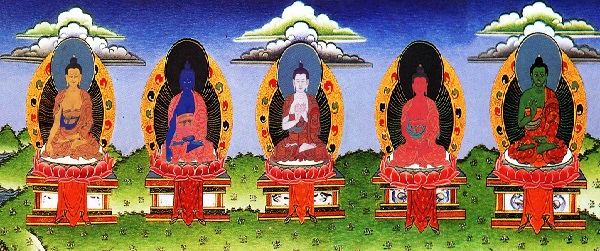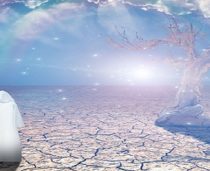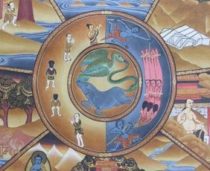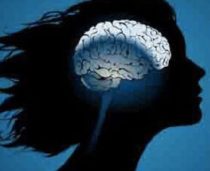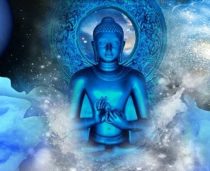So here we have the first two families: one is the Vairochana, and this is spaciousness, the color is white. It’s peaceful and transform’s anger. It’s also considered to be the family of the Buddha. In a negative way, the flipside of it could be fixed and insensitive. In Dilts’ work, we would say that this is spirit. This is like spacious nature. We would say that this is spirit, so it lacks many of the ability of Western language to define it, which is really the beauty of the Eastern thought. They have definitions for a lot of these things.
The next logical level is identity. First is spirit, so spirit is like the universal in a way. It’s the life force if you will. The next is identity, so this is the Akshobhya. This is like identity, this is clarity, this is fullness.
So the first is spaciousness, it’s like the emptiness in a way, the vastness, and this is the fullness. These two are complementary. The color here is blue because it’s not black, but this is the mirror-like sense of reflection. So this is the Vajra. The first was the Buddha. This is the Vajra. It’s brilliant, precise, there’s integrity, and it’s critical in a negative way. If there were an opposite of it, it would be critical, demanding in perfection. The feminine, the wisdom here whereas the spacious is the masculine and the compassion.
So here we have the mirror-like wisdom, and then we have the values, which Dilts defined the next level here as values, and that’s the richness, the Ratnasambhava, that’s memory, gold, yellow, equality, and self-satisfaction.
I’m looking at this like the past. It’s like the steps to the dance, you know, the explanation of it, the things upon which the future is built. So yeah, this transforms pride, shame, and guilt. The first one transforms anger, and the second one transforms stupidity. However, this one transforms pride, shame, and guilt. I think that this is sort of gratitude in a way. This is what is, it’s expansive; it’s appreciative in a way.
Next is beliefs and this is the passion, it’s red. This is the Amitabha. It’s also focus. This is the Padma family. While richness, the gold one above, is the Ratna family, this is the Padma family and it’s red. Sole experience without bias. This is experience without bias. It’s energizing, magnetizing, and charming. In the negative, it would be clingy and seek confirmation, so yeah.
So it transforms passion. Here, we transform passion, and I think passion and discontent here also. The self-conscious. Here I see this being like the present moment. This is the actual focal moment of the present moment. We’re still working on this, but these are the beliefs. So in Dilts’ work, these would be beliefs.
Next is behavior, and this fits perfectly, because behavior is also the Amoghasiddhi, or activity. This is the Karma family. In other words, passion lives in the Padma family, and this is in the Karma family. The color is green, and the swift, energetic, efficient, practical, appropriate, synchronous, and transforms jealousy. It fears embarrassment. It fears weakness and being less than.
So yeah, and then the flipside of it is power-hungry, controlling, and jealous. So this is behavior. I think actually that I have to reverse the order of these from this. I think that activity has to be the present moment; if there’s a present moment, then that would have to be it, obviously, right? And then the richness and the passion, the richness being the past and the passion being the future.
Then maybe we combine the beliefs and values into one, and if we combine them, now I’m just thinking out loud, and this is just stream of consciousness. I hope no one minds, if we combine beliefs and values. Then we have behavior, and we also have outcome, which really goes back into the past so that’s where that whole bit of it comes. That’s the richness. The outcome is the richness. Beliefs and values are the passion. Beliefs are the passion. Richness is like the outcome, and the past. So that would be after behavior and it sort of becomes chronological in that way. It’s after behavior, but it’s the past.
Clearly, and we think that we’re working on building a future but we’re really working on building a past.
Yeah, so identity. Interesting that many people think that it’s rock solid, but really it’s changeable.
Utilize the Power
So this is where I am in the work on this system. What I’m looking to do is to create a way to utilize the structure and the power in the five Buddha families in a different sort of a way, so that we can begin to see the way that the world works, through this lens. I think that this lens is going to be good. Every time that I’ve encountered a Buddhist teaching, there’s been a logic to it and a structure to it that is sensible and workable, and so that’s why I’m working with the five Buddha families right now, even though it’s a work in progress right now. So if you’re reading this, you’re getting a little insight into how my mind works and what we’re going to do. There you go.







